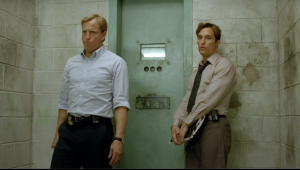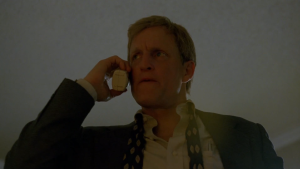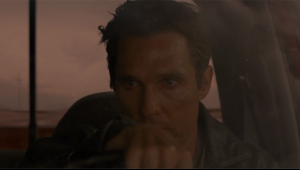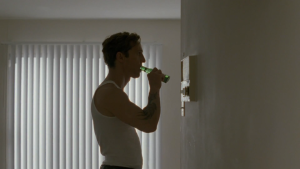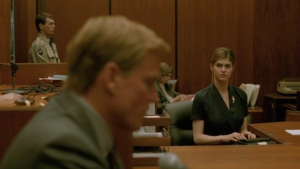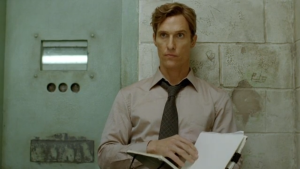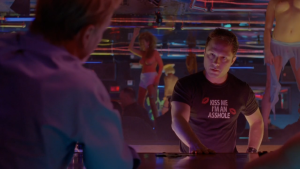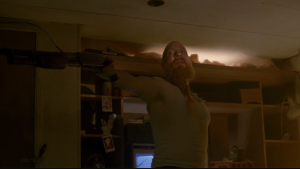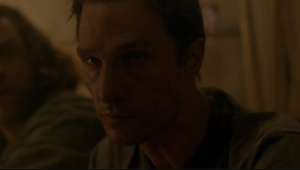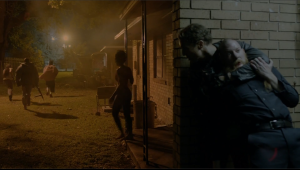Season 1, Episode 4: “WHO GOES THERE”
1995
“Who Goes There” opens with the return of Charlie Lange—Dora’s ex-husband—locked up in prison. Rust and Marty are irate with the man for apparently concealing information on his cellmate—Reginald LeDeoux—who the detectives have fingered as the most likely suspect in Dora’s murder. Charlie adamantly protests the accusations—growing more and more irate himself that Reggie could be responsible for Dora’s death. When further questioned, Charlie insists that Reggie is crazy in a very real and dangerous way—that he would often speak of devil worship and violence to women and children in a manner that even caused his fellow prison inmates to avoid him. Nonetheless, he gives up a known associate between them—Tyrone Weems—that may help the detectives track down Charlie’s whereabouts.
The next morning, Lisa confronts Marty about his drunken trespassing the other night—to which the latter basically shoves his mistress aside. This leads to Marty coming home to find his family absent…and a left note by Maggie. Marty immediately calls Lisa to confirm that she told Maggie about the affair. In an angry and drunken stupor, Marty then takes to the streets to find Tyrone. He tracks him to a nightclub, where he then pulls a gun on Weems for information on Ledoux. Weems confesses that he has fallen out of contact with him, but there are rumors that he only supplies his brand in bulk to one group: The Iron Crusaders. Marty passes along the information to Rust, who explains that he is familiar with the bikers from his days working undercover.
Marty drunkenly confronts Maggie during her hospital nightshift, until Rust manages to corral him with the news that he has a line on the Crusaders. Marty takes up temporary resident with Rust in the midst of this separation, where the latter decides that the two will have to go “off the books” in order to find Ledoux. Rust uses the excuse of having to visit his father in Alaska in order to reinstate himself in his undercover identity—stealing cocaine from the evidence room, injecting ink and cayenne to pass as a drug addict—while Marty adapts to his new life as a bachelor living in Rust’s apartment. Rust also reaches out to Maggie about the possibility of getting back with Marty, though she seems reluctant to do and insults Rust’s suggestions for rationalizing the situation.
A few days later, the big night has finally arrived. Rust makes contact with his former Iron Crusaders contact—Ginger—under the guise that he was formerly working security for a Mexican Cartel and is now breaking off to do his own thing. He wants to make a deal exchanging his cocaine (stolen rom the police evidence room) for the Crusaders’ meth dealer. Ginger agrees to connect the two under the condition that Rust helps rob a stash house in a housing project that night, which the undercover detective reluctantly agrees to. The Crusaders invade the stash house disguised as cops, and the robbery quickly turns awry. One of the residents is murdered, and a riot breaks out amongst the entire project. Rust quickly drops his undercover façade, coercing Ginger at gunpoint to cooperate, and manages to flee the chaotic scene with Marty acting as their getaway driver.
2012
Since most of the ’95 storyline involves Rust’s off-the-book behavior and “leave of absence”, the 2012 interviews are pretty much a moot point. Papania and Gilbough question inconsistencies in Rust’s story—most notably the fact that there are no records of his father’s leukemia—but these are small additions to their already strong suspicions surrounding Rust’s story.
——————————————————————————————————————————-
REVIEW
Despite being one of the most riveting episodes of the season, “Who Goes There” is also an episode that spends the most time on what seems like almost a complete diversion from the main case. Though the two detectives are obviously in search of Ledoux—the episode’s main narrative focus with Ginger allows for sequences of incredible tension and a long-take that stands as one of the best in television and filmmaking canon at large. Nonetheless, it’s also a storyline so completely removed from the laser-focus goals of normal episodes that it’s truly an anomaly of an episode on second rewatch. This isn’t so much a criticism, as a curious observation, as a great deal of material remains to be discussed in this noteworthy episode.
Starting with Charlie Lange, Dora’s former husband gives further subtle hints in identifying the unifying mythology of the Yellow King and Carcosa in his cell—remarking: “He [Charlie] said that there’s this place down south, where all these rich men go to…uh, devil worship…he said they sacrifice kids and whatnot…women and children…all got murdered there…and something about some place about Carcosa and the Yellow King…He said there’s just so much good killing there…Reggie got this brand on his back like in a spiral…he says that’s their sign.”
Past that, much of the Yellow King storyline is pushed to the side in favor of tracking down leads to Charlie LeDoux largely removed from the Yellow King. Likewise, the 2012 interviews are rendered a mostly moot point past further Cohle suspicions since his dying father excuse doesn’t match police records. Instead, the story pushes important character plot points forward—namely, Marty’s divorce. After a great scene of Marty giving his disposition toward justifying his breaking into a home—with Lisa glaring daggers at him as the court reporter and remembering his similar behavior (similarly unjustified) from the night prior—she confronts him about his abrasive and inappropriate behavior, which Marty more or less shrugs aside.
Marty’s problematic morals are underlined by Rust in the episode’s opening after the former criticizes Rust for reminding Charlie that it was “his fault…Guy was already low”. To which Rust respond, “…You’re funny, Marty. The shit you get soft about.” Though the prior episodes have routinely established Marty’s moral hypocrisy on multiple occasions—juxtaposing his sense of righteousness and values as a family man in his Papania and Gilbough interviews with ’95 scene of his infidelities—this episode finally sets the stage for the separation between Marty and his family that will result in his stark change of character in future episodes.
During Marty’s intense tracking and interrogations of Weems, as well, Marty finally exposes cracks in his psychology between his instinct for explosive violence and following the proper code expected of an officer. (There’s also a hilarious Easter Egg during Marty’s investigation wherein he must question a bartender—who is played by the show’s writer and exec producer Nic Pizzolatto—asking him “Why you make me say this, man?”)
Moreover, his and Rust’s decision to go completely off the books in the pursuit of their goal reveals a sense of moral similarity between the two and understanding when they believe it is appropriate to engage in more unlawful activities in the pursuit of a greater good. This unlawful activity, of course, is given the majority of the episode’s running time through Rust’s going undercover as an Iron Crusader. From his horrifying story about a Cartel’s routine for catching an undercover agent, to his stealing cocaine from the evidence room, to injecting ink and cayenne into his arm to pass for a heroin user, the sequence takes on a palpable level of dread and tension about this rendezvous with the bikers. Though Rust adapts to his undercover appearance with ease, there’s always an atmosphere of suspense hanging over every moment as the viewer waits for things to take a turn for the worst. And when Rust is seeing being driven away to Ginger’s headquarters to prepare for the heist, Marty’s sinking feeling of anxiety translates directly upon the audience. Then, watching Rust snort copious amounts of heroin while in a room with a gang of dangerous bikers and a hostage, this mood of heightened anticipation never abates.
Instead, Fukunaga amplifies and intensifies the suspense through a six-minute-plus uninterrupted single tracking shot of the robbery. With a soundtrack that perfectly mixes an unwavering and unsettling beat mixed with the chaotic noise of robbery gone awry, this unbroken shot elevates the tension of this moment into full-blown pandemonium. However, it is a controlled pandemonium—one that nearly overloads the viewer’s sensory expectations for how such a scene can unfold by refusing to break the rising suspense of the moment against the aggressively expanding wave of dread and confusion surrounding it.
Despite knowing that both detectives will obviously remain unharmed in their future 2012 interviews, this sequence just demonstrates with extraordinary aplomb—like the series itself—its incredible control of craft and ability to transcend typical production values as previously seen in television. A sequence easily able to stand against the Henry Hill’s Copacabana entrance of Goodfellas, anything by Paul Thomas Anderson, the Oldboy hallway fight…this is a tracking shot that imbues every element of emotion and narrative necessary to rank amongst the best and deserves to be applauded and remembered for doing so. Though no other moment in the series may rival this sequence from a technical standpoint, it’s one of the show’s most memorable and riveting—one that serves as an excellent endpoint to the series’ halfway mark.
